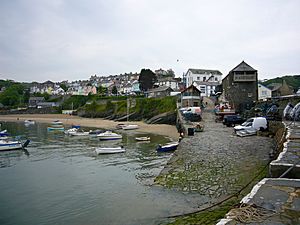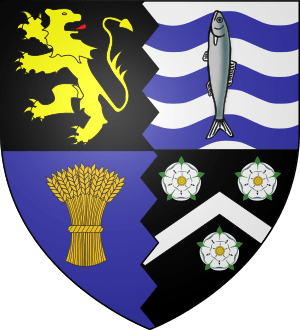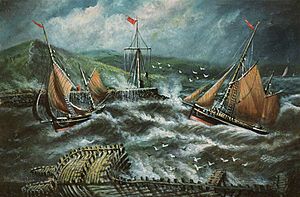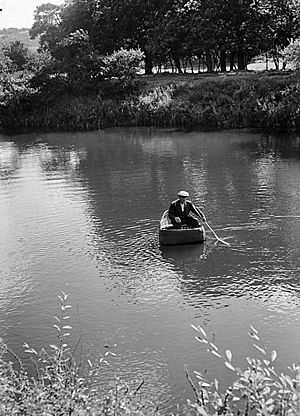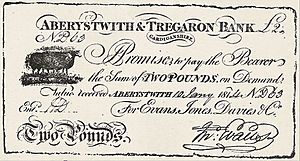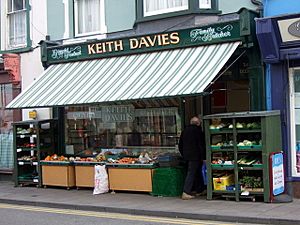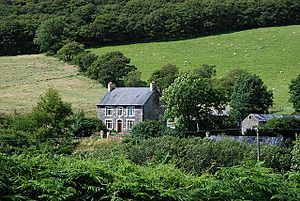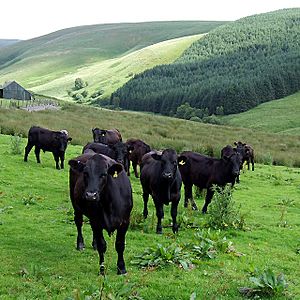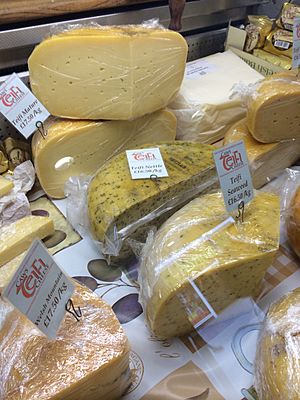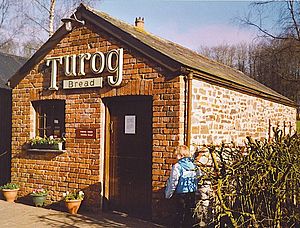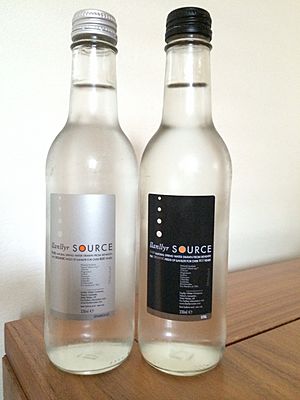Cuisine of Ceredigion facts for kids
The coast of Ceredigion has a long flat area. It features high cliffs, small coves, and large bays. Rivers like the Teifi and Dyfi flow into the sea here. The land becomes narrower towards the mountains in the north. The wide, rich Teifi valley is great for dairy farming and mixed farming. Heavy rain washes minerals from the soil. This makes the mountain soils poorer and more acidic. Farmers can only grow crops up to about 700 feet high.
Contents
- Sea Fish in Ceredigion
- Freshwater Fish in Ceredigion
- Lamb from Ceredigion
- Pork in Ceredigion
- Beef in Ceredigion
- Goat in Ceredigion
- Game in Ceredigion
- Poultry in Ceredigion
- Vegetables in Ceredigion
- Dairy Products in Ceredigion
- Bread, Cakes, and Puddings
- Fruit in Ceredigion
- Organic Produce in Ceredigion
- Drinks in Ceredigion
Sea Fish in Ceredigion
The sea around Ceredigion has always been full of fish. For many years, large groups of herring were caught in Cardigan Bay. Fishermen brought these fish to all Ceredigion ports. These included Aberaeron, Aberporth, and Aberystwyth. At Aberystwyth, more herring were caught after the harbour grew bigger in the 1700s. Between September and November, the fish were salted. Then they were packed in barrels. Trains carried them to England. Herring was also a key food for local people. They salted fish in autumn to eat during winter.
In South Wales, herring are called Ysgadenyn or Sgadan. In North Wales, they are known as Pennog. At Aberporth, herring were sold with a special saying:
Sgadan Aberporth,
Dau fola ac un corff,
Sgadan Aberporth,
Dau enaid mewn un corff
Aberporth herrings,
two bellies in one body.
Aberporth herrings,
two souls in one body
Swper Scadan, or Supper Herrings, is a traditional baked dish. It uses six to eight herrings. The fish are cleaned, scaled, and filleted. People spread mustard, salt, and pepper inside each fillet. Then they roll the fillets. These are placed on thin slices of potato, onions, and apples. More sliced potatoes, seasoning, and a spoon of sage go on top. Boiling water is added. The dish bakes in foil. The foil is removed near the end to brown the potatoes. This recipe is interesting because it shows how Welsh kitchens cooked before frying pans. Boiling, roasting, and stewing were common cooking methods. Kitchen tools included the griddle, a tripod for roasting, the bakestone, and a large iron pot. Salted herrings were also roasted on the tripod.
The importance of fishing, especially herring, is shown in the county's coat of arms. These arms were officially given on October 21, 1937. They feature a herring against a sea background. This symbol shows Ceredigion's fishing history.
Mackerel (Macrell) are also common in Cardigan Bay. They are in season from late June to early September. They taste best when fresh. Writer Bobby Freeman said mackerel are best when their "sea-green colours are very brilliant and beautiful, and the eyes are bright". In Ceredigion, mackerel was usually fried. People used vegetable oil or olive oil. Olive oil was brought to Ceredigion ports from the Mediterranean through trade. In the 1880s, fishermen from Aberaeron and New Quay reportedly caught over a million mackerel in two nights. The fish sold for a very small price. Any unsold fish was used as fertilizer on fields.
Monkfish is often caught in Cardigan Bay. Chef Colin Pressdee says this fish is great for kebabs. Its flesh is firm, not flaky. He also notes that the large tail can be roasted like a leg of lamb. This is why it's called 'gigot de mer' in French. Some restaurants in Ceredigion cook monkfish this way. They serve it with a red wine sauce.
Teifi Fish Bake is a local fish dish. It uses cod and smoked haddock fillets. These are skinned, cut into cubes, and covered in a parsley sauce. Diced potato and Teifi cheese are added. The dish is then baked and decorated with fresh parsley.
Shellfish gathered from the shore were once a key food for Ceredigion families. One old dish mixed scrambled eggs with limpets (llygaid meheryn) and common periwinkles (gwichiaid). These were then fried in bacon fat. Limpets were also boiled with nettle tips to make them soft. Then they were fried in oatmeal. S. Minwel Tibbott wrote a recipe for Limpet Pie (tarten lygaid). This is a traditional dish from Aberporth. Limpets are boiled for half an hour. Then bacon and leeks are added to a pastry-lined dish. It is then baked. Sand eels (llymriaid) were also eaten. They were usually fried in bacon fat.
Lobster and other shellfish are important to Ceredigion's seafood industry. By the 1980s, lobster numbers in Cardigan Bay were very low. So, the Development Board for Rural Wales started a program to restock them. Between 1984 and 1988, 19,000 baby lobsters were tagged and released near Aberystwyth.
Fishing has been a tradition in Ceredigion for many years. However, commercial fishing greatly reduced fish numbers. Today, fishing is mostly done by local, part-time boats. Gilli Davies says this means fish shops and restaurants in places like Aberaeron often serve fish caught the same day. This is different from deep-sea fishing, where fish might be at sea for up to two weeks.
The importance of seafood to the local economy is now celebrated. The Cardigan Bay Seafood Festival happens every July at Aberaeron harbour. Aberaeron also has an annual Mackerel festival. This takes place in late August and early September. It celebrates how important this fish is to the town's economy.
Freshwater Fish in Ceredigion
Freshwater fish were also a key part of the Ceredigion diet. The River Teifi is famous for its salmon and sewin. The river starts near Tregaron. It flows through a valley that once had many large houses. Then it reaches the sea at Cardigan. In the 1800s, salmon was so common that servants asked not to eat it more than three times a week. Because of this, 'Teifi salmon sauce' is found in many old Welsh recipe books. These recipes often used a lot of butter. This was common in country house cooking back then.
Lady Llanover wrote about cooking salmon in her book. She gave detailed steps for 'crimping' fresh salmon. This helps the flesh 'set' before it becomes oily. Fennel grows wild in Ceredigion. It was often used in sauces for fish, especially salmon and mackerel.
Gerald of Wales wrote about the amazing sight of salmon leaping at Cenarth waterfalls. Bobby Freeman remembered running a hotel in Pembrokeshire in the 1960s. Salmon from the River Teifi would be delivered by bus. The bus conductor carried boxes of fish to the kitchen. The fish were packed in cool, fresh bracken. Each box held six or seven large fish.
Salmon season in Wales is from February to October. But most fish run from June to September. In the river, salmon use energy to produce eggs for spawning. So their flesh can quickly get worse. For this reason, Pressdee says to avoid darker, thinner fish. These fish are ready to spawn and should be left in the river. Wild salmon have a firmer texture and stronger flavour than farmed salmon. This is because they eat shellfish. Farmed salmon are easier to find. But they have softer flesh and a more buttery taste.
Trout are also common in Ceredigion's rivers. They are farmed at Rhydlewis Trout Farm. Trout are raised in pools fed by the Teifi and Ceri rivers. They are smoked in wooden chambers.
Lamb from Ceredigion
The taste of lamb from Welsh Mountain Sheep changes with the area. Ceredigion's coastal cliffs get strong westerly winds. These winds cover the cliffs with salt spray. The spray lands on goose grass, which the lambs eat. This affects the meat's flavour. Along river mouths and salt marshes, like the Dyfi Estuary Mudflats, wild spearmint, samphire, and sea beet grow. Lambs eating these plants have a rich, salty taste. Lamb from mountain areas, like Cader Idris, eats purple heather in summer. This gives the meat a more fragrant flavour.
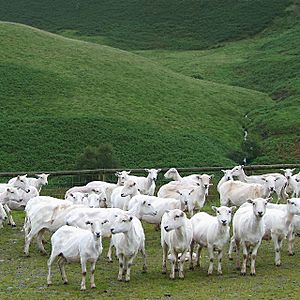
The season also affects the taste of Welsh lamb. Spring lamb is sold from May each year. It is sweet and mild. Pressdee says it's perfect for light spring casseroles. Autumn lamb has a stronger, gamey flavour. But it can be richer. Adding fresh, wild field mushrooms can make it even better.
Welsh Mountain Sheep are smaller than other British sheep. But their meat is sweeter and has more meat near the bone. The shoulder of Welsh lamb is usually juicier and has more fat than the leg. However, it's hard to carve. So, shops often sell boned and rolled shoulder of lamb.
Until the 1800s, mutton was a popular dish in Wales. But farming changes and new food tastes made it less common. It is no longer a main food. However, you can still find it in old Victorian recipe books. These books often included salted mutton and 'Welsh Mutton Hams'. Mutton was common in Ceredigion restaurants for Victorian tourists.
The importance of sheep to Ceredigion's economy is seen on old banknotes. A bank called the Aberystwyth and Tregaron Bank used to exist in Ceredigion. The number of black sheep on each banknote showed its value in pounds. The £5 and £10 notes showed one or two rams. This bank was also known as the Black Sheep Bank.
Pork in Ceredigion
Pigs have been an important food in Ceredigion since Medieval times. They are even mentioned in the Laws of Hywel Dda. Until the mid-1900s, almost every home kept a pig in the backyard. Welsh cookbooks often have recipes based on "bacon-plus-potatoes". Killing the family pig was a community event. Parts of the pig that couldn't be salted or eaten were given to neighbours. Each pig provided faggots, sausages, puddings, brawn, and haslet. Haslet and faggots are still popular in Wales. You can often buy them at local markets. Haslet is sometimes called aislet or islet in Wales.
Pressdee mentions that traditional butchers in Ceredigion still exist. They make dry-salted Welsh bacon and gammon from local pork. This meat is usually good value and easy to find. The cheapest cut of pork is 'cig moch', or belly pork. Each farmhouse used to cure its own bacon. The crackling from the belly, if cooked until crisp, was seen as the tastiest part.
Sheila Barry shared memories of keeping pigs on Penrallt Farm. This was in Llangranog, after World War II. Pigs were killed in cold weather to keep the meat fresh. Barry said the farm killed two pigs a year. The first was killed in November or early December. If killed later, it would clash with preparing poultry for Christmas. The second pig was killed in early March. The pig fat was melted into lard. This lard was cleaned and stored in large jars. It was used for pastry and roasting. Barry noted that lard could last for years if covered and kept cool. However, the lean meat had to be eaten within ten days. So, families would give meat to neighbours. Neighbours would then do the same when they killed their pig. The offal (internal organs) was used for brawn and faggots. After hanging for three days, the rest of the pig was cut. It was then salted to make bacon. Salt was rubbed into the meat twice a day for three or four weeks. Each bacon joint was wrapped in fine muslin. It was hung from hooks in the living room ceiling to mature. Barry recalled this practice stopped around 1953. Farms became more commercial then.
Beef in Ceredigion
Welsh Black cattle are a small but strong breed from Wales. They eat many types of plants. This gives their meat a good flavour. At Llanerchaeron, the National Trust has a working farm. It has Welsh Black cattle and other farm animals. They show how a country house, its service area, and the farm work together. Visitors can see farm activities throughout the year.
Many local farms are family-run, like Golwg y Môr. They supply local restaurants and shops. Their cattle graze on coastal grass. This makes the meat tender and flavourful.
Goat in Ceredigion
Goat meat was a main food in Wales for longer than in England. This is because goats were better suited to Wales's rough land. Goat hams were often called 'hung venison'. It's not popular now. But the old writer Thomas Pennant said 'hung venison' was cheap and plentiful food in Wales during winter.
Game in Ceredigion
In Ceredigion, old estates from famous Welsh country houses now offer wild shooting. The Trawsgoed Estate, near Aberystwyth, is one example. It covers over 5,000 acres of marshes and wetlands around Tregaron Bog. Here, people hunt pheasant, snipe, mallard, Eurasian teal, widgeon, and hares. The Monachty Shoot is an old hunting ground. It's a 1500-acre estate near Aberaeron. It includes pheasant and duck. Cefngwyn Hall, south of Aberystwyth, offers semi-wild duck shooting. It has 25 pools across 400 acres.
Pheasant are raised commercially. Then they are released into the wild. They spend one or two seasons eating grain, berries, worms, and roots. This diet gives their meat a deep, rich flavour. The flavour improves if the bird is hung for several days in a cool, airy place. Pressdee suggests eating pheasant with a rich old Burgundy wine or Rhone wine. He believes semi-wild birds taste better than those fed commercial food.
In Wales, some venison farms have free-range deer. They cull their animals when they are young and tender. Venison can be cooked like beef, lamb, or pork. Many recipes use venison, which has a rich flavour.
Rabbits are common in Wales. You find them on undisturbed open land and along the shoreline. The meat is tender and delicate. It can be used in many ways, including casseroles.
Poultry in Ceredigion
Most rural families traditionally kept geese or ducks. Geese would eat in the fields after harvest. This helped them get fat quickly. Welsh hill-farms used goose feathers for bedding. Large goose feathers were used to sweep the hearth in the kitchen. Smaller wing feathers were used for brushing flour or oatmeal when baking. Goose meat was also used in cawl (a type of soup). Michaelmas Goose, or Gwydd Mihangel, is a recipe where the goose is boiled in water. Chopped onions, salt, and pepper are added. It's thickened with oatmeal. This thick, fatty broth was popular in cold weather. Goose cawl was also part of the feast a farmer gave his tenants when they paid rent.
Vegetables in Ceredigion
The potato has been a main vegetable in Wales since it arrived. Many interesting recipes have come from it. Potato Harvest Pudding (Poten Ben Fedi) is a traditional Sunday supper dish. It was made in late September and October, after the potato harvest. Another traditional dish is Roast Potatoes and Bacon (Tatws Rhost a Bacwm). This was cooked in a pot oven over the fire. Potatoes and bacon are a traditional mix in Welsh cooking. The plainness of the potato is balanced by the saltiness and fat of the bacon. If potatoes weren't available, cabbage would be used. This made a Bacon and Cabbage dish (Cig Moch a Chabaits). The cabbage was cooked in the bacon's liquid.
Leeks are strongly linked with Wales. But Freeman notes there are few recipes just for them. At one time, they were the only onion-family plant that grew all over Wales. They are even mentioned in the Laws of Hywel Dda, like cabbage. One famous dish is Pastai Cennin (Leek pasty). It mixes leeks with a shortcrust pastry.
Cawl is a soup or broth. It was an important dish across Wales. Traditionally, it was eaten with a special wooden cawl-spoon. This spoon kept people from burning their mouths on the hot broth. The broth was usually drunk first. Then the meat and vegetables were eaten. This is similar to the French dish pot-au-feu. Today, cawl is eaten all at once. Wooden spoons and bowls are less common now. Cawl is traditionally served with just a piece of wholemeal bread and a chunk of cheese.
There is no single cawl recipe. But in New Quay, it was traditionally made on the beach. This was on the first day of August as a special feast for sailors. One woman oversaw making the cawl in a large cauldron. Each family gave some ingredients, like beef or fresh garden vegetables. Because many vegetables were available in summer, cawl was best then. It was known as Cawl Awst.
Tregaron has its own cawl recipe, called Tregaron Broth (Cawl Mamgu Tregaron). It's made from meat and vegetables boiled in water. Leeks are added later. Vegetables usually include parsnip, potatoes, carrots, swede, and white cabbage. The meat includes bacon and shin beef (beef shank). The ingredients are boiled with oatmeal to thicken. It simmers for as long as needed. The leek is added 10 minutes before serving. Cawl is a key part of Welsh food. Bobby Freeman said it is "an unspoken part of life" in Wales.
Dairy Products in Ceredigion
Ceredigion is known for its dairy products. This is because of its good pastures. In the past, milk was sent daily to London. So, Ceredigion has an important dairy industry. Besides milk, it's famous for its cheese and yoghurt.
Gilli Davies notes that in Wales, the system of transhumance meant cheese was made on farms for longer. In summer, butter and cheese making were part of the hafod economy. The hafod was a summer home for Welsh farmers. It was in the hills, where livestock could graze well. However, the acidic soils in the uplands made hard cheeses harder to produce. Traditionally, drovers took sheep to market in England. They often traded sheep for hard cheese, usually Cheddar cheese. They used this for their 'caws pobi' or welsh rabbit.
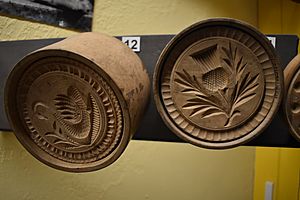
In the 1900s, cheese making in Ceredigion saw a rebirth. Ty'n Grug is a farm that makes cheese. It's seen as a leader in organic cheeses in Wales. It makes cheese from cow, goat, and ewe milk. Varieties include Teifi, Penbryn, and Felin Gernos (from cows' milk). Merlin is from goats' milk, and Acorn is from ewes' milk. The owner, Dougall Campbell, moved to Ceredigion in 1976. He became a pioneer in Welsh cheese. He led the "renaissance in farmhouse cheese-making". By 1984, few organic dairy farms in Ceredigion sold milk to the Milk Marketing Board. They got no extra money for organic milk. Campbell started Welsh Organic Foods. This supported organic milk producers. It became the first organic-cheese company in Britain. He also taught people about organic cheese. The Soil Association created the Dougal Campbell Memorial Fund in his honour. The Specialist Cheesemakers Association offers an award for new cheese makers, named after him.
Tyn-y-Llwyn is a farm that makes cheese near Pontrhydygroes. The farm makes a firm Cheddar-type cheese. It has been making cheese since 1986. Anglo-Nubian goat, Alpine goat, and Saanen goat breeds provide milk for the cheese.
Little Acorn Products started in 1985. Back then, cheese from ewes' milk was rare. Karen and Don Ross started the business from their kitchen. They began by making one cheese a day. They carefully recorded the process. Their ewes' milk cheese is like an old-fashioned Wensleydale. They also make cheeses from cows' milk. One is called Monks of Strata Florida, named after a local monastery.
Penbryn Organic Farmhouse Cheese is made by Paul Knifton and Andrea Degen. They used to make Gouda cheese in Ireland and Holland. The cheese moulds are filled with curd. Each is wrapped by hand. They are stored for 8-10 months to improve the flavour. Varieties include a Penbryn Mature cheese. Gilli Davies says they "produce some of the best cheese produced in Wales today". Teifi Farmhouse Cheese is made at Ffostrasol, Llandysul. It is considered one of the finest farmhouse cheeses in Wales.
Rachel's Organic was started by Rachel Rowland at Brynllys Farm. This is a 254-acre organic farm in Dolybont, near Borth. Four generations of her family have owned it. In 1982, a snowstorm blocked access to the farm. To avoid wasting milk, they made butter for local use. Butter, yoghurt, and cheese production soon followed. Rachel's grandmother was a dairy teacher at UCW, Aberystwyth. She developed organic methods using science.
Bread, Cakes, and Puddings
Organic wheat is still stone-ground in small flour mills across Wales. Slow grinding keeps the whole wheat germ. The warm friction between the mill stones gently releases the wheat oil. This keeps all the nutrients. In Ceredigion, Felin Ganol, at Llanrhystud, is a restored flour mill. It still has its original machines. It is the only working water-powered mill in Ceredigion. The Prince of Wales visited it in 2012.
Bread and cakes were made daily and for special events. These events often followed religious or farming calendars. Freeman notes that cakes came later in Welsh cooking. This was when the bakestone was replaced by the oven. Sheep shearing is still a major social event in Welsh rural life. During this time, farmers help each other gather and shear sheep. The host farm spends days making pies, cakes, and baked meats. Cacen Gneifo, or Shearing Cake, is a traditional cake made then. It is flavoured with caraway seeds. The Threshing Cake, or Cacen Ddyrnu, is made at threshing time. It uses buttermilk and bacon fat, which are always on Welsh farms. Teisen Carawe, or Seed Cake, also uses caraway seeds. It is one of the oldest Welsh egg-raised cakes. It is linked with chapel and Sunday tea. An old Ceredigion recipe is Christmas Cake, or Teisen Ddu Nadolig. It usually includes some home-brewed ale.
Commercial bakeries grew in towns in the 1800s and early 1900s. They met the needs of town dwellers who didn't bake their own bread. People brought their prepared dough to the bakery in baking tins. They paid the baker to bake it. This was because town houses had iron ovens attached to kitchen ranges. These were not considered good for baking bread. The Derwen Bakehouse was one of three such bakeries in Aberystwyth. It served the local community from about 1900 to 1924. It was rebuilt at the National Museum of History in the mid-1980s. It is a working bakery. Visitors can see bakers using traditional wooden tools and a large brick oven.
Pancakes, called poncagen (poncagau) or pancosen (pancos) in Ceredigion, are as traditional as cawl. They could be made quickly on the bakestone over the fire. They were often made for unexpected visitors or as a birthday treat. They were also eaten at high tea. Pancakes are still popular. They are best made with buttermilk and bicarbonate of soda, not regular milk. Most Welsh country house recipe books include pancake recipes using cream. This was seen as a special treat.
Waffles are newer to Ceredigion's food scene. Local production started in the 1980s. Tregroes Waffles is run by Kees Huysmans and Ans Brouwer. They came to Ceredigion from Holland in 1981. They started with a simple waffle iron. They offered their first waffles at a Guy Fawkes party in Henllan in 1984. They have since moved to a larger place in Llandysul.
Trifle and rice pudding are still very popular in west Wales. Freeman says trifle is almost always the "obligatory 'finale' to a special occasion feast". Rice pudding is expected to be rich and creamy.
In 2012, the Ceredigion Federation of Women’s Institutes published a recipe book. It was called “Cardi Cuisine”. It celebrated their 90th anniversary. It also marked hosting the WI Wales Conference at Aberystwyth. The book had over 90 recipes from WI members. These included traditional bread and cake recipes. Examples are Parsnip Bread, Bara Brith, Shearing Cake, Welsh Cakes, Llanddarog Fair Cakes, and Welsh Tea Buns.
Fruit in Ceredigion
Fruit growing is mostly for home use. Each farm has its own apple, plum, or damson tree. However, soft fruit is rare in mountain areas due to acidic soil. But it may be grown commercially where the soil is less acidic. Pen Caled is a traditional apple from Ceredigion. It's good for making cider. It has a full, sharp taste and is low in tannin. It can also be used as a late-season cooking apple. Pren Glas is an apple from the St Dogmaels area. It's an early-season eating apple. Both apples are available from commercial growers. Like elsewhere in Wales, Welsh apples and fruit varieties might be rediscovered. A full study of traditional Welsh plant diversity is still needed.
Wild fruit is also collected. This includes blackberry (mwyar), whinberry (llus), wild raspberry (afan), and wild cranberry. Cranberries can be found in the boggy uplands of Ceredigion. Gooseberry and rhubarb are also commonly grown in gardens.
Fruit tarts, including turnover tarts, were traditionally made on the bakestone. No plate or dish was used. Sugar was only added after the fruit was cooked. This was done by lifting the pastry lid. Then the sugar was worked into the fruit. Making a tart on the bakestone needed skill. It also required a special wooden slice.
Organic Produce in Ceredigion
Ceredigion's farming traditions go back many generations. But new ideas from alternative lifestyles have added to traditional ways. This has made the local community richer. So, besides traditional Welsh foods like butter and bacon, new foods are eaten. These include pulses, beans, and soya milk. Also, there has been a shift from using artificial fertilizers to organic pastures. Horticulture (growing plants) has increased. There is more production of high-quality produce.
Drinks in Ceredigion
Dà Mhìle is an independent whiskey distillery. It started in 2012 with help from the Springbank Distillery. It is based at Glynhynod Farm. It is said to be the first organic, farmhouse distillery in the UK. The distillery makes organic whiskey. It offers guided tours by arrangement. It also makes an organic orange liqueur called Dà Mhile Orange 33.
Freeman notes that home-brewed beer is "a legend" in rural Wales. Family recipes are closely guarded. One farm that now makes beer commercially is Panteg Farm, at Maen-y-groes. Penlon Cottage Brewery offers beer tastings and events. They make ten types of ales, lagers, and stouts. They use traditional methods and vegetarian recipes.
Celtic Country Wines is located at Henllan, Llandysul. It makes fruit wines, liqueurs, and country preserves. The winery welcomes visitors and has a gift shop.
Traditionally, ginger beer has always been popular. It's a non-alcoholic choice instead of regular beer. There are two kinds of Welsh ginger beer. One uses a gingered herb to make 'small' beer. The other uses root ginger.
Tŷ Nant is a 350-year-old farm near Bethania, Ceredigion. The farm has bottled spring water since 1986. The Tŷ Nant brand started in 1989. It is known for its unique cobalt blue glass bottles. These bottles won a design award. They were the first to use dark blue glass since Phillip's Milk of Magnesia. Llanllyr is bottled water drawn since 1180 at an organic farm in Talsarn. It is available throughout Wales.


